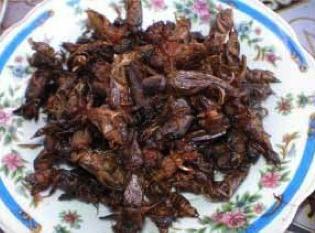How does a bear look like: a photo and description of an insect
Medvedka belongs to the order of the orthopteran familyof insects. The adult grows up to 3.5-6 cm. It is an omnivorous pest. Earthworms, caterpillars of butterflies, larvae of ladybirds, May beetles, dragonflies, pupae of different insects - all this is included in its diet. Medvedka damages all kinds of cultivated plants and most wild-growing plants, biting their roots underground. She eats both seeds, and tubers, and the roots of adult plants, and young sprouts, damaging not a few pieces, but on the root destroying all the planted seedlings.
How the bear looks
The nearest relatives of the bear are a cricket and a grasshopper, but it is not like them at all. And what does the bear look like? She has a very unusual appearance, the big abdomen is 2/3 of the whole body.
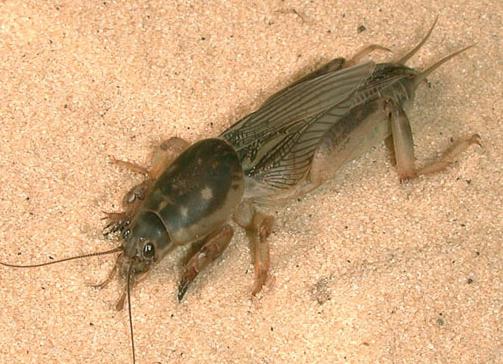
The powerful front part of the body consists of connectedhead and chest, forming a cephalothorax. It is protected by a chitinous shell, where the bear is capable of pulling his head in case of danger. The abdomen is soft, with two shaggy outgrowths.
The first pair of 6 available legs is designed fordigging passages under the ground and resembles turned out with a thickened shank the feet of a mole. The Latin name of the bear Gryllotalpa is translated into Russian as "mole-cricket". In young individuals, wings are not developed, and adults have real wings that allow them to fly. Adult insects have a brown color with a lighter belly, in young medvedok the body is slightly lighter than in adults.
Reproduction of the bear
In the spring, when the soil warms up to 12 degrees Celsius, the overwintered individuals come out of the earth. Like crickets, males and females of the bear attracted the elect in the evening and at night chirring.

The female digs under the ground a nest with dense wallsand a round arch. In late spring and early summer, she lays in a prepared hole of 250 to 600 eggs. Find out what the eggs of a bear look like, if you can find such a nest and open it. There you can see small, like millet grains, eggs 3-3.5 mm in size, yellowish-gray in color.
Since the hole of the bear is very unusual, itscan not be confused with anything. It is necessary to find it in the soil and destroy it before the insects swarm the entire site. The nest is so dense that if you find it, you can take it out of the ground with your hands, and it will retain its shape. The pest digs in the ground a lot of tunnels that go under the surface of the soil in different directions, but from the nest to the surface the tunnel is dug along a spiral line, and that the nest does not fill the water, special outflows are made from the main tunnel. Thus, by the way the bear's moves look, you can understand whether they lead to the nest or not.
How does a little bear
Places where these insects settled, you can find outon loose platens on the surface of the soil and holes similar to the yields of wormholes, but smaller. Above the nest of plants does not remain, as the female bites all the roots, trying to make the site the maximum warmed by the sun's rays. The bear protects its offspring, removes parasitic fungi from eggs and larvae. The larvae leave the eggs after 2 weeks.
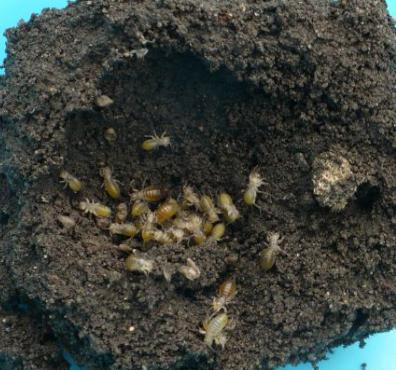
Before becoming an adult, the larva molts 8-9time. It is difficult to know, since the larva of the bear in the first age does not look like an adult insect and not as representatives of subsequent ages. The larvae of this period are bright, resemble spiders, but, unlike the latter, they do not have 8 legs, and 6. They are blind and inactive, they feed on the embryonic yolk that they have in the goiter. After the first moult, the larvae feed on humus, then they pass to the basic diet of adult medvedok.
After 25-30 days, the larvae leave the nest, andeach looks just like an adult bear, but smaller and without wings. The larva of the first age reaches a size of 15 mm, the second - 20, the third - 25, and the fourth (pronymph) - 35 mm. Thus, by the way the larva of the bear looks and what size it is, you can determine its age. In early autumn, the population of teddy bears consists of adult insects (imago) and larvae predominantly of the 3rd-4th age
Where the wolf hibernates

Adult bear and larvae hibernate in the soil invertically arranged courses. Adults go to a depth of 1 meter, and larvae - up to 0.5 m. The overwintered larvae differ from adults by undeveloped wings. After a few more lines, they become adults by the end of the second summer of their life. The number of lines depends on the climate of the site. In the more southerly regions, the moult is smaller, and the development occurs more quickly.
Distribution area
The habitat is well-moistenedsoil, while it can and swim, and dive, and fly, and also runs fast and excellently digs underground passages. He prefers to settle near water bodies in flooded meadows, but can live far from water, avoiding only the most arid places. Medvedka lives in all countries of Eastern and Western Europe, except for the northernmost regions, in all countries of Asia, in America and North Africa.
This is a very ancient insect, which is evident even inthe way the beetle looks like a bear. It should be noted that it is not right to call it a bug, they are called in the entomology of representatives of the order of coleoptera, and the bear is a representative of a squad of orthopteran insects. Given this circumstance, we can talk about how the insect looks like a bear. They appeared on Earth more than 3 million years ago and during this time perfectly adapted to very different living conditions.
Chemical, agrotechnical and biological methods of destruction

When eating larvae, the bear can reducethe number of May beetles and butterflies. In the wild, it brings enough benefits, which outweighs the damage that is inflicted on plants. But, unfortunately, she quite often settles on cultivated lands, in gardens and greenhouses. It can appear and even overwinter in a dunghill or compost. If you use manure, without giving it a foul, the land will be infected not only by insects, but also by seeds of weeds.
Since the harm from the bear is more obvious in the cultivated areas, for many centuries of farming man has developed many different ways to reduce the number of insects.
- Use of chemicals. They are very effective in fighting insects. The use of insecticides requires compliance with all instructions, which is often ignored. But the poison that kills one organism can not be harmless to another! In general, organophosphorus insecticides and baits processed by them are used, which are buried in the soil ("Phenaxin plus", "Medotox"). In the spring, before planting, greenhouses use baits in greenhouses, and in autumn, when the crop is harvested, and the bear is still active, pyrethroids are used for fumigation, that is fumigating the greenhouse with the use of substances safe for humans and animals, but killing insects.
- Agrotechnical measures used forpest control. These methods include techniques that create adverse conditions for pests. This method is cheaper than others and lays the foundation for ecologically clean agricultural products. An example is loosening and digging of soil, observance of optimum terms of planting of plants, weed control, use of mineral fertilizers.
- Use of biological agents fordestruction of the bears. Theoretically, they have no competitors in their effectiveness. The main principle is the use of specially developed drugs that cause fungal or parasitic disease in insects.
- There is another technological method,scaring away the teddy bears from small areas. On its site you can install ultrasonic "scarers". It is necessary that they work always, otherwise the insects will return to the site.
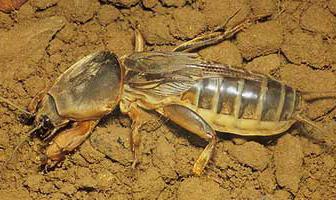
Folk and mechanical ways of fighting
Among the folk ways of fighting pests isvery effective methods. These include the use of decoctions of different plants, planting plants that pests do not tolerate, the use of traps. You can bury in the land of banks filled with water for 2/3, the bear that gets there can not independently get out. They do not like the smell of some flowers, for example, marigolds and chrysanthemums. An interesting way of scaring off is to install a vane turntable on the site. On thin poles it is possible to fasten them a little. When they rotate, the vibration is transferred to the soil, and if there is a "beetle" bear, it leaves the site.
The oldest method is mechanicaldestruction of the bears. Insects are manually collected and destroyed, digging traps, cleaning manure from pests. All of them are very effective, but very laborious and unpleasant, since the bear looks intimidating. These methods are suitable for small areas.
Attraction of natural enemies to the site
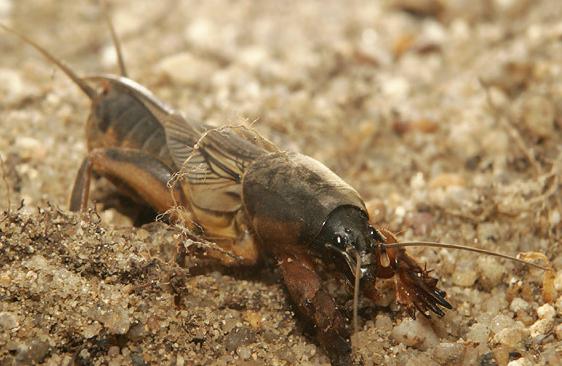
Use of natural enemies refers to notvery popular methods, they do not bring the same moral satisfaction as mechanical, but they are the most logical. Such methods include attraction to the site of birds, lizards, frogs. Medvedka eats small bitterns, starlings, rooks, as well as lizards and shrews. Often they are perceived on the site as uninvited guests, and many of them simply need to be protected, since the benefits of their presence are obvious.
What should I do if there are newborns on the site
The best are methods that take into account the naturepest. In order to get rid of the bear, it is necessary in spring and early summer to loosen the rows between 15-20 cm to locate and destroy the nests of the insect. In the same period, you can leave dung for attracting females, and when they arrange a nest there, scatter manure and destroy nests. In autumn, when the bear is seeking refuge for wintering, effective is digging holes in the ground with depths of 0.5-0.7 m, filling them with manure. Such pits are attractive to them, they get into the dung, and when frost begins, manure must be extracted from the pits and scattered on the surface of the soil. Both adult insects and larvae can not stand the cold and die.
When laying greenhouses must be carefullyTo scan the soil for the detection of adult insects or nests, it is necessary to dig the trap grooves around the greenhouse. From the manure intended for greenhouses, it is necessary to choose and destroy the bear. Knowing what the bear looks like, you definitely will not miss it.


